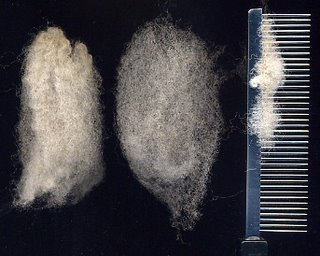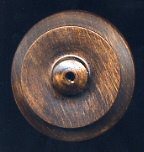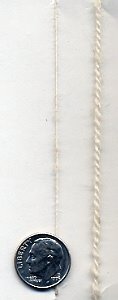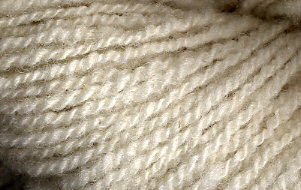As Cheryl mentioned in the comments, she had previously soaked the fleece to clean it, so that no further scouring was required on my part. To prepare the staples for handcarding, I used my dog comb to open up both the tip and butt ends. I was able to remove quite a few short bits and neps this way.

For the first 50 grams of fiber, I removed 14 grams of waste and used 36 grams for spinning. Of course, a dog comb doesn't remove all the waste, but it took out quite a bit. This preparation handcarded into lovely rolags.
If I had an entire fleece to play with, I would have planned to make lots of sample yarns to experiment with yarn size and twist. Since I had a lesser amount and wanted to make the most of it, I decided to let the crimp determine the twists per inch. The fleece will have a natural tendency to follow its crimp, so this is a good starting point for experimenting with twist. There was some variation throughout my sample, but the the mean crimp was 8 per inch. Therefore I planned to spin my yarn with 8 twists per inch.
But..... how to do this. It would have been an easy calculation if I was spinning short draw. Then, all I would have required was a whorl with an 8:1 ratio. Drafting one inch per treadle would have put 8 twists in that inch of yarn. But I wanted to spin long draw. So I needed to know how many treadles for an 18 inch length of yarn. Of course, with an 8:1 twist ratio, simple math would tell me that I needed to treadle 18 times. Easy enough.
 Next, I took a look at the possible twist ratios of my two wheels. The Ashford Traditional double drive offers ratios of 7.5, 10, or 14:1. Close, but not exact. My Kromski Minstrel offers 6.5, 8.5, 12, or 16:1. Again close. My choices then, were to either approximate the twist by using one of the whorls that came with my wheels, or to pull out Mabel Ross's The Essentials of Yarn Design for Handspinners, one of my favorite spinning books. Among her many handy charts (this one on page 53), was one that suited my Ashford 6.5:1 twist ratio.
Next, I took a look at the possible twist ratios of my two wheels. The Ashford Traditional double drive offers ratios of 7.5, 10, or 14:1. Close, but not exact. My Kromski Minstrel offers 6.5, 8.5, 12, or 16:1. Again close. My choices then, were to either approximate the twist by using one of the whorls that came with my wheels, or to pull out Mabel Ross's The Essentials of Yarn Design for Handspinners, one of my favorite spinning books. Among her many handy charts (this one on page 53), was one that suited my Ashford 6.5:1 twist ratio. The beauty of these charts is that the math is already done for me. All I had to do was to look at the left hand column for the twists per inch I wanted, and then look on that row under the "Longdraw Treadles per 18 in." column to find the information I needed. As you can see, I needed to treadle 24 times per 18 inch draft of fiber.
The beauty of these charts is that the math is already done for me. All I had to do was to look at the left hand column for the twists per inch I wanted, and then look on that row under the "Longdraw Treadles per 18 in." column to find the information I needed. As you can see, I needed to treadle 24 times per 18 inch draft of fiber. When I did this and allowed the yarn to twist back upon itself, I was happy with the results.
When I did this and allowed the yarn to twist back upon itself, I was happy with the results.The Particulars:
Fiber Weight, 36 grams
Fiber length, 3 inchs
Occasional neps
Spinning ratio 6.5:1
Spun woolen method
24 treadles per 18 inch draft
Singles, 32 WPI
2-ply, 18 WPI
Yardage, 74
I plied it according to the yarn on my sample card.
The yarn:
 It's a very elastic yarn with a nice hand and luster. When I finish spinning all of it, I will knit up a swatch. It would make wonderful socks. Or a vest or sweater. Then too, I'll be interested in what Cheryl eventually does with hers.
It's a very elastic yarn with a nice hand and luster. When I finish spinning all of it, I will knit up a swatch. It would make wonderful socks. Or a vest or sweater. Then too, I'll be interested in what Cheryl eventually does with hers.© 2006 Leigh's Fiber Journal
5 comments:
This is really interesting as I have Mabel Ross's book but have never really put the information into action as you have explained it. Thank you.
Holy smokes! That's really getting into your spinning. Good for you. The math and me ... ummmm, I majored in English. Heh!
Hey Chris, that's why I use the charts!! ;)
Well, I have to say that I have not (and most probably will not) put that much thought into what I spin up with the Galway Cross! Actually, I've spun some of it this summer and came out with some lovely yarn that would do nicely for socks. But obviously my product didn't come out NEARLY as nicely as your handful! Well done!
Thanks for commenting at my blog. Imagine my pleasure when I popped over here and found so. much. information. I really look forward to learning a lot more about spinning from reading here.
Post a Comment